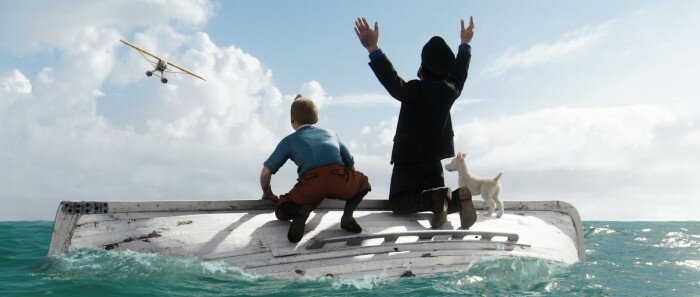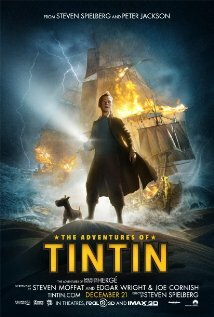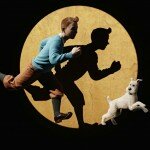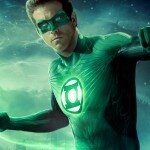Now that we’ve collectively agreed Indiana Jones and the Kingdom of the Crystal Skull never happened, let us return to fawning over Steven Spielberg for that kind of “gee whiz, let’s do that again!” giddiness you get from watching movies like The Adventures of Tintin: The Secret of the Unicorn. The director might be working from a collection of mid-20th century comics by Belgian artist Hergé, but this is undeniably Spielberg channeling Spielberg, almost to the point where if he gave this ginger-tuft adventurer a whip and a fedora, he’d have delivered the kind of alien-free Indiana Jones sequel we yearned for back in 2008.
But worry not, Hergé fans; the ink-blotted Tintin of yore has not been forgotten nor besmirched in this audacious 3D adaptation. That much is clear in the opening scene where a street artist — looking suspiciously like the late Hergé himself — paints a profile of Tintin (voice of Jamie Bell; Defiance) in his iconic two-dimensional likeness, the first of many ‘wink-wink’ allusions to the beloved source material. No one can deny that Spielberg and producer Peter Jackson have gone to great lengths to capture the lightly comical, historically focused and distinctly European vibe of the comics, even in the face of a largely unaware American audience who will probably think they’re watching The Adventures Conan O’Brien instead. This is one for the fans, and even if that’s not you, consider this your chance to become one.
In what is hopefully the first of many, Tintin’s first Hollywood adventure begins with the young reporter’s eye being drawn to a model ship – the titular Unicorn — on sale in a Brussels marketplace, which he snaps up for a bargain. Moments later, a rather baleful looking collector, Ivan Sakharine (Daniel Craig; Cowboys & Aliens), offers to buy the model off of Tintin for a hefty sum, but he declines, intrigued to know what makes this particular model so desirable. Leave it to Snowy, Tintin’s wily fox terrier, to sniff out a cryptic piece of parchment hidden in the mast, hinting at a secret treasure Sakharine no doubt intents to get his hands on. Sensing a good story, Tintin and Snowy board Sakharine’s ship as the collector sets out to recover another clue he believes is in somewhere Morocco. On board, they bump into the boisterous Scotsman Captain Haddock (mo-cap king Andy Serkis; Rise of the Planet of the Apes), who is too drunk to remember what he has to do with anything, but not quiet drunk enough to forget that it’s very, very important.
![the-secret-the-unicorn-pic10[1] the secret the unicorn pic101 e1324559010120 600x274 The Adventures of Tintin: The Secret of the Unicorn (Review)](/wp-content/uploads/the-secret-the-unicorn-pic101-e1324559010120-600x274.jpg)
Fans will be quick to point out that this swashbuckling story — penned by a British screenwriting supergroup comprised of Edgar Wright (Shaun of the Dead), Steven Moffat (Doctor Who) and Joe Cornish (Attack the Block) — is actually a mixture of three Tintin adventures: The Crab with the Golden Claws (1941), The Secret of the Unicorn (1943) and Red Rackham’s Treasure (1944). The fact that narrative still manages to feel somewhat underwritten and incomplete despite such a bevy of material is a little surprising, I’ll admit, but the film barely slows down long enough for anyone to notice. It’s relentless alright, but relentless in the best kind of way, lurching from dazzling set-piece to dazzling set-piece with just enough exposition in-between to keep the mystery unraveling at a pace the whole family will appreciate. Any doubt I previously had towards the eerie, photo-realistic animation style — and believe me, I had plenty — was diminished by the sheer beauty and spectacle of the action, none of which could be been so vividly and kinetically realised had it been filmed live. There’s undeniably still work to be done in evoking the “soul” of a real performance, but the CG virtuosos at Weta Digital successfully avoid falling into the uncanny valley by keeping physicality of the characters loyal to that of the comics rather than the actors. Thus, we don’t see Jamie Bell, Andy Serkis and Daniel Craig; we see Tintin, Haddock and Sakharine. And that distinction is what makes it easier to give yourself over to the world of Tintin than that of The Polar Express, where I couldn’t shake the feeling that I was watching zombie Tom Hanks drive a train.
I suppose my only real problem with The Adventures of Tintin is, well, Tintin. Let’s face it, the Belgian reporter is bit of a colourless character; a drearily earnest and asexual boy scout without a discernible quirk to call his own. I don’t blame Hergé for this, because in print, such nondescript characterisation allows the reader to imbue their own traits and values into the protagonist. But with film, the audience takes a more passive, observational role, leaving it up to the filmmakers to shape these characters for you. It’s the reason why Bond orders a shaken Martini and Indy loathes snakes. It makes them more than just a hero. It makes them human.
Nevertheless, Snowy does most of Tintin’s emoting for him, and Captain Haddock has enough eccentricities to sink a battleship – which, come to think of it, he does eventually. All in all, this is a wonderfully entertaining rollercoaster ride, a signature Spielbergian adventure that almost makes me wish the directing great would have another crack at reviving Indiana Jones again.
Just, you know, go easy on the aliens…
 Follow the author Anders Wotzke on Twitter.
Follow the author Anders Wotzke on Twitter.


 The Adventures of Tintin: The Secret of the Unicorn (Review 2)
The Adventures of Tintin: The Secret of the Unicorn (Review 2)











